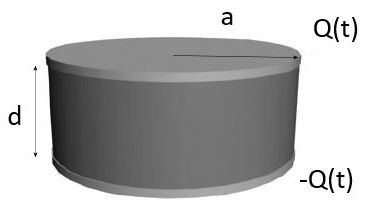More Problems
Problem 1:
A conducting loop of area A and resistance R lies perpendicular to a uniform magnetic field B. The loop is then rotated at a uniform rate until it is upside down in time t. Find the work done in flipping the loop.
Solution:
- Concepts:
Faraday's law, induced emf - Reasoning:
The magnetic flux through a filamentary loop is changing with time. This flux change induces an emf and causes a current to flow.
For filamentary circuits: emf = -d/dt(∫B∙ndA) = -d/dt(BAcos(ωt)) = ωBAsin(ωt). - Details of the calculation:
I = emf/R, dW/dt = I*emf = (ωBA)2sin2(ωt)/R,
W = (1/R)(ωBA)2∫0Δt sin2(ωt)dt = (1/R)(ω(BA)2∫0π sin2(x)dx.
The work done is W = ωπ(BA)2/(2R).
Problem 2:
A capacitor consists of two parallel circular plates of radius a separated by a distance d. The capacitor is initially charged to a charge Q0. At t = 0, this capacitor begins to discharge because we insert a circular resistor of radius a and height d between the plates, such that the ends of the resistor make good electrical contact with the plates of the capacitor. The capacitor then discharges through this resistor for t ≥ 0, so the charge on the capacitor becomes a function of time Q(t). Throughout this problem you may ignore edge effects.

(a) Use Gauss's Law to find the electric field vector between the
plates.
(b) For t ≥ 0, consider an imaginary open surface of radius r < a inside
the capacitor with its normal dA upward. For t ≥
0, what is the current flowing through this open surface in terms of Q(t)
or dQ(t)/dt and the parameters given? Define the direction of positive current to be upward, and be careful about signs.
(c) For this same imaginary open surface, what is the time rate of change of the
electric flux though the surface, in terms of Q(t) or dQ(t)/dt and the
parameters given?
(d) What is the integral of the magnetic field around the contour bounding this
open circle, using the Ampere-Maxwell Law? Be careful of signs.
(e) Does your answer in (d) make sense in terms of the energy dissipation and
energy flow in this problem?
Solution:
-
Concepts:
Maxwell's displacement current -
Reasoning:
As the capacitor discharges, a current flows through the circular resistor and the electric field between the plates decreases.
∇×B = μ0j + (1/c2)∂E/∂t = μ0(j + ε0∂E/∂t) .
Between the plate we have 2πr B(r) = ∫Aμ0(j + ε0∂E/∂t)·dA.
Here ε0∂E/∂t is Maxwell's displacement current density. -
Details of the calculation:
(a) Let the z-axis point up.
Gauss' law for E yields E(t) = σ/ε0 = Q(t)/(ε0πa2). E = -Q(t)/(ε0πa2) k.
(b) Consider the charge on the upper plate.
Q = CV, dQ/dt = -V/R = -Q/(RC) = -Q(t)d/(Rε0πa2). Q(t) = Q0exp(t/(RC)).
For t ≥ 0, I = dQ/dt = -Q(t)d/(Rε0πa2). The current flowing from the upper to the lower plate, dQ/dt is a negative number.
j = I/(πa2) k = (dQ/dt)/(πa2) k = -Q(t)d/(Rε0π2a4) k.
Let i(r) be the current flowing through the open surface of radius r.
i(r) = ∫Aj·dA = -(r2/a2)Q(t)d/(Rε0πa2) = (dQ/dt)(r2/a2).
(c) dE/dt = -(dQ(t)/dt)/(ε0πa2) k. dE/dt points upward.
The time rate of change of the electric flux through the surface is
dΦE/dt = ∫A(dE/dt)·dA = -(r2/a2)(dQ(t)/dt)/ε0.
dΦE/dt = -i(r)/ε0.
(d) j + ε0∂E/∂t = 0, the integral of the magnetic field around the contour bounding this open circle is zero, B is zero everywhere.
(e) No field energy flow from outside into the capacitor volume. The energy dissipated as heat was previously stored in the electric field.
Problem 3:
Consider a classical particle mass m and charge -q uniformly distributed
throughout a spherical volume of radius R. The particle is spinning about an
axis through its center with angular frequency ω.
(a) Find the angular momentum of the particle in terms of the given quantities.
(b) Find the magnetic moment of the particle in terms of the given quantities.
(c) If you assume that the electron is a classical particle mass me
and charge -qe uniformly distributed throughout a spherical volume,
what is the precession frequency Ω of a free electron in an external
uniform magnetic field B making an angle θ with the direction of its
magnetic moment?
(d) The electron is a spin ½ particle with a magnetic moment μ = -(2μB/ħ)S.
The Bohr magneton μB = qeħ/(2me).
If you use the measured magnetic moment μ = -(2μB/ħ)S
of the electron, what is the precession frequency Ω of a free electron in
an external uniform magnetic field B making an angle θ with the
direction of its magnetic moment?
Solution:
- Concepts:
Torque on magnetic dipoles, precession - Reasoning:
We can consider the spinning sphere to be made up of a series of rotating rings. Each ring constitutes a current loop. Current loops have magnetic dipole moments. - Details of the calculation:
(a) Choose the coordinate system so that the particle spins about the z-axis, ω = ω k.
L = Iω = (2/5)mR2ω.
(b) μ = ½∫V r×j(r) dV.
There are various ways to evaluate this integral.
For example: j(r) = ρer sinθ ω eφ, [r×j(r)]z = rsin θ ρersin θ ω.
μ = k ½∫∫∫ ωρer2sin2θ r2dr sinθ dθ dφ = (π/5)R5ρeω ∫0π sin3θ dθ = (4/3)(π/5)R5ρeω.
μ = -(1/5)qR2ω.
(c) For part (c), assume B points in the +z-direction.
τ = μ × B = -(μ/L) L × B = (μB /L) k × L = ½qB/m.
τ = dL/dt = Ω × L.
Ω = (μB /L) k = ½qeB/me k.
(d) Using the measured magnetic moment Ω = qeB/me k.